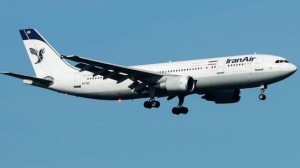 File photo shows an Iran Air Airbus A300-605R passenger plane.[/caption]
File photo shows an Iran Air Airbus A300-605R passenger plane.[/caption]TEHRAN (ISNA)- Iran plans to import three new Air Bus airliners in the near future, said Managing Director of Iran's Taban Airline Asqar Abdollahpour.
"The required measures for the delivery of the three new airplanes are underway and they are of Airbus a321 class," he told ISNA.
The planes will enter Iran from Sweden and will be rented monthly in Iran, Abdollahian said, adding the Iranian airline now holds 5 airplanes.
Taban Airline located in Mashhad, northeastern Iran, has started its activities officially in 2005.
The Airbus A321 is a stretched first derivative of the standard A320. The variant was launched in 1988, when the A320 began operations. Compared with the A320, the A321's major change is the stretched fuselage, which is lengthened by 6.94 meters (22 ft 9 in); the A321 is the largest of the A320 family. This is achieved by adding a front plug immediately forward of wing 4.27 m (14 ft 0 in), and a 2.67 m (8 ft 9 in) rear plug. To maintain performance, double-slotted flaps were included, in addition to increasing the wing area by 4 m2 (43 sq ft), to 128 m2 (1,380 sq ft).
Other minor modifications were made to accommodate the A321-100's 9,600 kg (21,200 lb) increase in maximum takeoff weight to 83,000 kg (183,000 lb). The maiden flight of the first of two prototypes came on 11 March 1993. The A321-100 entered service in 1994.
The basic A321-100 features a reduction in range compared to the A320 as extra fuel tankage was not added to the initial design to compensate for the extra weight. To overcome this Airbus launched the heavier and longer range A321-200 development in 1995 which has a full-passenger transcontinental US range.
This is achieved through higher thrust engines (V2533-A5 or CFM56-5B3), minor structural strengthening, and an increase in fuel capacity with the installation of one or two optional 2,990 L (790 US gal) tanks in the rear underfloor hold.
The additional fuel tankage increases the total fuel capacity of this model to 30,030 L (7,930 US gal). These modifications also increased the maximum takeoff weight of the A321-200 to 93,400 kg (206,000 lb).
By ISNA
The Iran Project is not responsible for the content of quoted articles.










